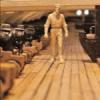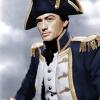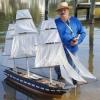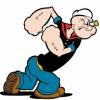-
Posts
401 -
Joined
-
Last visited
Reputation Activity
-
 Force9 got a reaction from Bill Morrison in USS Constitution by Force9 - Revell - PLASTIC - Revisiting the classic 1/96 kit
Force9 got a reaction from Bill Morrison in USS Constitution by Force9 - Revell - PLASTIC - Revisiting the classic 1/96 kit
Continuing along the theme of Old Ironsides
As usual, I've gone crazy with the hobby knife and peeled back a bit of the lower hull - this time to reveal the stout framing of an American Heavy Frigate.
I've gone ahead and used the 1875 photo as guidance and spaced my frames accordingly:
Russ here at MSW confirms that the 1875 photo should be accurate. Research confirms that the keel on Old Ironsides is original as well as most of the futtocks and flooring. This would dictate the spacing of the frames for the life of the ship - even if the contours of the upper framing changed over the years.
The placement of my gash is not arbitrary - it is actually symbolic. Captain Dacres testified in his court martial after the battle that "on the larboard side of the Guerrière there were about thirty shot which had taken effect about five sheets of copper down.." This was most likely the result of Constitution's initial broadside which Captain Hull had held back until his ship was directly alongside his opponent at half-pistol shot range. The blast fairly rocked Guerriere and sent "washtubs" of blood pouring down her hatches according to an eyewitness. The damage below the waterline ultimately sealed her fate. The prize crew couldn't stem the flow and Hull ordered her blown up the next morning.
My representation here should give folks an idea of just how much damage the Guerriere absorbed from the outset of the fight. -
 Force9 got a reaction from CIWS01 in USS Constitution by Force9 - Revell - PLASTIC - Revisiting the classic 1/96 kit
Force9 got a reaction from CIWS01 in USS Constitution by Force9 - Revell - PLASTIC - Revisiting the classic 1/96 kit
Thank you Tim, Christian, Stuart, and Frank for your continued interest... Thanks to everyone who clicked the LIKE button!
Tim - I'm not sure where a kit bash crosses over to becoming a scratch build... I'm almost certain that I've modified every kit component I've used or otherwise replaced it with something scratch built. I really don't think I've yet used anything straight from the box. All part of the fun!
Stuart - I used Plastruct rod 4.0mm and 4.8mm (#s 90862, 90863) for the wheels/trucks. I made a simple jig using scrap styrene to keep a consistent width. I used drill bit sizes 11/64 and 3/16 to drill holes in the styrene that I built up to the appropriate thickness. After snipping off some narrow slices from the rod, I'd insert them into the jig and file them flush to the styrene surface. I made multiple holes in the jig surface so that as the jig was worn down with the filing I could rotate to another hole and maintain the approximate width. I could make a dozen or so before everything was filed down too far and I had to add new holes to the jig.
Haven't had much shop time, but slowly making more wheels.
Thanks for keeping tabs
Evan
-
 Force9 got a reaction from WackoWolf in emergency steering chains
Force9 got a reaction from WackoWolf in emergency steering chains
Hallo Dirk
This topic has been very interesting to me because it reminded me of a conversation I had many years ago (1997?) with a docent on board the USS Constitution. A small group of us were discussing the rudder and I mentioned something about the emergency steering chains. The docent corrected me and insisted that the rudder chains had nothing to do with steering. He pointed out that they were attached to the counter with eyebolts and couldn't possibly be used to control the rudder. He said they were used to preserve the rudder and extended under the entire counter and attached at several points so that the stress could be distributed if they suffered a hard pull and increased the chance that the chains held fast if the rudder was jarred loose. This made sense to me and seems to be reflected in the majority of contemporary (Napoleonic period) ship models. That was the source of my comments - I admit it may not be authoritative.
I know you have Harland as a reference. He states: "[Rudder chains] were shackled to a stout metal strap bolted to the rudder-horn, the upper after corner of the afterpiece of the rudder, just above the waterline. The chain was becketted loosely around the counter, to allow the rudder sufficient play, and to the forward ends were spliced rudder-pendants, which were made fast to the mizzen channels. The main purpose of the rudder chains was to secure the rudder, should it be jarred loose from going aground. In addition, by rigging tackles on the pendants, they could, at a pinch, be used to steer."
"Becketted loosely" would seem to correspond with Daniel's representation and the restored Victory in Portsmouth.
To add to the confusion... I've been using my own pictures of the Hull model as references for my Constitution build. As you may already know, this model was built by the crew and presented as a gift to Captain Isaac Hull. The model shows a slightly different arrangement:
It is likely that the crew didn't have access to any scale chain and had to use rope instead, but I wonder if the heavy served rope under the counter is accurate and the thinner rope leading up from the rudder should be chain. The heavier line is terminated abruptly under the quarter gallery and is not led up to the mizzen channel:
I'm not sure we can settle anything either way, but it seems that modeler's will need to determine which source matches best to their own perspective and go forward with that...
Evan
-
 Force9 got a reaction from mtaylor in emergency steering chains
Force9 got a reaction from mtaylor in emergency steering chains
Hallo Dirk
This topic has been very interesting to me because it reminded me of a conversation I had many years ago (1997?) with a docent on board the USS Constitution. A small group of us were discussing the rudder and I mentioned something about the emergency steering chains. The docent corrected me and insisted that the rudder chains had nothing to do with steering. He pointed out that they were attached to the counter with eyebolts and couldn't possibly be used to control the rudder. He said they were used to preserve the rudder and extended under the entire counter and attached at several points so that the stress could be distributed if they suffered a hard pull and increased the chance that the chains held fast if the rudder was jarred loose. This made sense to me and seems to be reflected in the majority of contemporary (Napoleonic period) ship models. That was the source of my comments - I admit it may not be authoritative.
I know you have Harland as a reference. He states: "[Rudder chains] were shackled to a stout metal strap bolted to the rudder-horn, the upper after corner of the afterpiece of the rudder, just above the waterline. The chain was becketted loosely around the counter, to allow the rudder sufficient play, and to the forward ends were spliced rudder-pendants, which were made fast to the mizzen channels. The main purpose of the rudder chains was to secure the rudder, should it be jarred loose from going aground. In addition, by rigging tackles on the pendants, they could, at a pinch, be used to steer."
"Becketted loosely" would seem to correspond with Daniel's representation and the restored Victory in Portsmouth.
To add to the confusion... I've been using my own pictures of the Hull model as references for my Constitution build. As you may already know, this model was built by the crew and presented as a gift to Captain Isaac Hull. The model shows a slightly different arrangement:
It is likely that the crew didn't have access to any scale chain and had to use rope instead, but I wonder if the heavy served rope under the counter is accurate and the thinner rope leading up from the rudder should be chain. The heavier line is terminated abruptly under the quarter gallery and is not led up to the mizzen channel:
I'm not sure we can settle anything either way, but it seems that modeler's will need to determine which source matches best to their own perspective and go forward with that...
Evan
-
 Force9 got a reaction from dafi in emergency steering chains
Force9 got a reaction from dafi in emergency steering chains
Daniel/Dirk...
I've also read the Steel description as well as some others and I think you've correctly assessed the description... I interpret this as saying that there are RUDDER CHAINS and there are RUDDER PENDANTS that attach to the rudder chains. The rudder chains serve the central purpose of securing the rudder and aiding in preventing the rudder from turning too far - which creates drag and can damage the rudder and/or stall the steering. A longer length of chain is commonly used (but not always) and attached to eye bolts under the counter to distribute the stresses should the chain get yanked with force if the rudder is wrenched loose in a storm or grounding. Additionally, it made sense to attach a rope (pendant) to the rudder chain so that the chains could also be used for emergency steering in the rare case where the rudder head is damaged, but the remainder of the rudder is still intact enough to function.
Many contemporary models show rudder chains fitted, but not rudder pendants. I would think a prudent commander would rig the pendants prior to a battle for emergency use - a stern rake is precisely the situation where the rudder head might be too damaged to support an auxiliary tiller.
In the case of emergency steering, RUDDER TACKLES are the series of blocks and rope that give mechanical advantage and link directly to the tiller head, pendants, or chains (depending on damage and contingency) to allow control in steering the ship with the damaged rudder.
Clear as mud???!!!
Evan
-
 Force9 got a reaction from foxy in USS Constitution by Force9 - Revell - PLASTIC - Revisiting the classic 1/96 kit
Force9 got a reaction from foxy in USS Constitution by Force9 - Revell - PLASTIC - Revisiting the classic 1/96 kit
Thank you Tim, Christian, Stuart, and Frank for your continued interest... Thanks to everyone who clicked the LIKE button!
Tim - I'm not sure where a kit bash crosses over to becoming a scratch build... I'm almost certain that I've modified every kit component I've used or otherwise replaced it with something scratch built. I really don't think I've yet used anything straight from the box. All part of the fun!
Stuart - I used Plastruct rod 4.0mm and 4.8mm (#s 90862, 90863) for the wheels/trucks. I made a simple jig using scrap styrene to keep a consistent width. I used drill bit sizes 11/64 and 3/16 to drill holes in the styrene that I built up to the appropriate thickness. After snipping off some narrow slices from the rod, I'd insert them into the jig and file them flush to the styrene surface. I made multiple holes in the jig surface so that as the jig was worn down with the filing I could rotate to another hole and maintain the approximate width. I could make a dozen or so before everything was filed down too far and I had to add new holes to the jig.
Haven't had much shop time, but slowly making more wheels.
Thanks for keeping tabs
Evan
-
 Force9 got a reaction from Hank in British official Report of the Prince de Neufchatel vs Endymion battle
Force9 got a reaction from Hank in British official Report of the Prince de Neufchatel vs Endymion battle
It is interesting how an official report attempts to put the best spin on what both sides would seem to agree was a bloody repulse. Amazing how these privateers - which generally weren't heavily manned - were able to hold off such assaults... Reid's crew did even better in the famous incident in the Azores near the end of the war.
Great to read thru these accounts.
Evan
-
 Force9 got a reaction from CaptainSteve in USS Constitution by Force9 - Revell - PLASTIC - Revisiting the classic 1/96 kit
Force9 got a reaction from CaptainSteve in USS Constitution by Force9 - Revell - PLASTIC - Revisiting the classic 1/96 kit
Thank you all for the LIKES!
Now let's discuss the kit gun barrels...
We know that the 1807 pattern 24 pdrs on Constitution measured 9' 6" and the OOB versions match nicely:
The kit provided barrels are perfectly fine, but they lack a certain menace... They seem a bit thin to me. With that in mind, I had included some of the white metal versions in one of my Bluejacket orders for comparison:
These are a nicer fit, I think... They have more of the requisite girth I'm looking for and they generally show similar proportions to the 1794 pattern preserved in South Carolina:
But where have I seen a barrel like that before...? Aha - the Heller Victory:
The Heller kit includes a bunch of these barrels to represent both the 32 pdr and the 24 pdrs on the lower decks. I have two Heller Victory kits, so it'd be no big deal to repurpose a set for my Connie build. Heck, I could utilize the Connie 24 pdrs on the Victory down the line...
Now notice how the trunnions are represented on the Heller versions... They sit off center down lower. We see this in the 1794 pattern barrel as well. This positioning allowed for a better depression angle when sitting in the gun carriage, but was inherently weaker than center cast trunnions. The 1807 pattern 24 pdrs apparently utilized the trunnions on the centerline.
Here is how the barrels would need to sit if the barrel is mounted properly:
This looks fine, but the upward angle is a little awkward sticking out of the gun port. Mounting the same barrel upside down gives a better angle out of the gun port and sits down nicely in the carriage:
But the gnawing fact remains that it is upside down. The solution is to remove the molded trunnions and add the properly centered trunnions:
Much better. Looks like I have more holes to drill... Be back in a week or so!
Thx
Evan
-
 Force9 reacted to johncole in Puritan by johncole - Mamoli - 1/50 scale - 1885 America's Cup
Force9 reacted to johncole in Puritan by johncole - Mamoli - 1/50 scale - 1885 America's Cup
It was a productive weekend.
I made some metal bits to mount the bowsprit, and everything eventually fit into place.
I think the hull and deck are nearly done, except for boat davits.
Next up; building the masts. This will be really interesting for me since I've only built the AL Swift before this. I know this rig is just a sloop, but it does have some degree of detail that I'll have to study so I don't goof up and install things in the wrong places. Mamoli seems to have a concise rig plan, but there are some differences when compared to old photos.
John
-
 Force9 got a reaction from JerseyCity Frankie in USS Constitution by Force9 - Revell - PLASTIC - Revisiting the classic 1/96 kit
Force9 got a reaction from JerseyCity Frankie in USS Constitution by Force9 - Revell - PLASTIC - Revisiting the classic 1/96 kit
Thank you all for the LIKES!
Now let's discuss the kit gun barrels...
We know that the 1807 pattern 24 pdrs on Constitution measured 9' 6" and the OOB versions match nicely:
The kit provided barrels are perfectly fine, but they lack a certain menace... They seem a bit thin to me. With that in mind, I had included some of the white metal versions in one of my Bluejacket orders for comparison:
These are a nicer fit, I think... They have more of the requisite girth I'm looking for and they generally show similar proportions to the 1794 pattern preserved in South Carolina:
But where have I seen a barrel like that before...? Aha - the Heller Victory:
The Heller kit includes a bunch of these barrels to represent both the 32 pdr and the 24 pdrs on the lower decks. I have two Heller Victory kits, so it'd be no big deal to repurpose a set for my Connie build. Heck, I could utilize the Connie 24 pdrs on the Victory down the line...
Now notice how the trunnions are represented on the Heller versions... They sit off center down lower. We see this in the 1794 pattern barrel as well. This positioning allowed for a better depression angle when sitting in the gun carriage, but was inherently weaker than center cast trunnions. The 1807 pattern 24 pdrs apparently utilized the trunnions on the centerline.
Here is how the barrels would need to sit if the barrel is mounted properly:
This looks fine, but the upward angle is a little awkward sticking out of the gun port. Mounting the same barrel upside down gives a better angle out of the gun port and sits down nicely in the carriage:
But the gnawing fact remains that it is upside down. The solution is to remove the molded trunnions and add the properly centered trunnions:
Much better. Looks like I have more holes to drill... Be back in a week or so!
Thx
Evan
-
 Force9 got a reaction from Crowler in USS Constitution by Force9 - Revell - PLASTIC - Revisiting the classic 1/96 kit
Force9 got a reaction from Crowler in USS Constitution by Force9 - Revell - PLASTIC - Revisiting the classic 1/96 kit
Folks...
I've just returned from a business/holiday trip to the East coast. I somehow managed to be on hand when Old Ironsides put up her sails and proceeded along on her own power for the first time since 1997 - albeit for only 1,000 yards or so. It was done to commemorate her great victory over HM Frigate Guerriere exactly 200 years hence. After her brief sail, the tug brought her in close to the fort on Castle Island where she fired off her obligatory 21-gun salute to the roaring approval of the gathered throng.
Enjoy -
 Force9 got a reaction from msberkman in USS Constitution by Force9 - Revell - PLASTIC - Revisiting the classic 1/96 kit
Force9 got a reaction from msberkman in USS Constitution by Force9 - Revell - PLASTIC - Revisiting the classic 1/96 kit
Thank you all for the LIKES!
Now let's discuss the kit gun barrels...
We know that the 1807 pattern 24 pdrs on Constitution measured 9' 6" and the OOB versions match nicely:
The kit provided barrels are perfectly fine, but they lack a certain menace... They seem a bit thin to me. With that in mind, I had included some of the white metal versions in one of my Bluejacket orders for comparison:
These are a nicer fit, I think... They have more of the requisite girth I'm looking for and they generally show similar proportions to the 1794 pattern preserved in South Carolina:
But where have I seen a barrel like that before...? Aha - the Heller Victory:
The Heller kit includes a bunch of these barrels to represent both the 32 pdr and the 24 pdrs on the lower decks. I have two Heller Victory kits, so it'd be no big deal to repurpose a set for my Connie build. Heck, I could utilize the Connie 24 pdrs on the Victory down the line...
Now notice how the trunnions are represented on the Heller versions... They sit off center down lower. We see this in the 1794 pattern barrel as well. This positioning allowed for a better depression angle when sitting in the gun carriage, but was inherently weaker than center cast trunnions. The 1807 pattern 24 pdrs apparently utilized the trunnions on the centerline.
Here is how the barrels would need to sit if the barrel is mounted properly:
This looks fine, but the upward angle is a little awkward sticking out of the gun port. Mounting the same barrel upside down gives a better angle out of the gun port and sits down nicely in the carriage:
But the gnawing fact remains that it is upside down. The solution is to remove the molded trunnions and add the properly centered trunnions:
Much better. Looks like I have more holes to drill... Be back in a week or so!
Thx
Evan
-
 Force9 got a reaction from foxy in USS Constitution by Force9 - Revell - PLASTIC - Revisiting the classic 1/96 kit
Force9 got a reaction from foxy in USS Constitution by Force9 - Revell - PLASTIC - Revisiting the classic 1/96 kit
Thank you all for the LIKES!
Now let's discuss the kit gun barrels...
We know that the 1807 pattern 24 pdrs on Constitution measured 9' 6" and the OOB versions match nicely:
The kit provided barrels are perfectly fine, but they lack a certain menace... They seem a bit thin to me. With that in mind, I had included some of the white metal versions in one of my Bluejacket orders for comparison:
These are a nicer fit, I think... They have more of the requisite girth I'm looking for and they generally show similar proportions to the 1794 pattern preserved in South Carolina:
But where have I seen a barrel like that before...? Aha - the Heller Victory:
The Heller kit includes a bunch of these barrels to represent both the 32 pdr and the 24 pdrs on the lower decks. I have two Heller Victory kits, so it'd be no big deal to repurpose a set for my Connie build. Heck, I could utilize the Connie 24 pdrs on the Victory down the line...
Now notice how the trunnions are represented on the Heller versions... They sit off center down lower. We see this in the 1794 pattern barrel as well. This positioning allowed for a better depression angle when sitting in the gun carriage, but was inherently weaker than center cast trunnions. The 1807 pattern 24 pdrs apparently utilized the trunnions on the centerline.
Here is how the barrels would need to sit if the barrel is mounted properly:
This looks fine, but the upward angle is a little awkward sticking out of the gun port. Mounting the same barrel upside down gives a better angle out of the gun port and sits down nicely in the carriage:
But the gnawing fact remains that it is upside down. The solution is to remove the molded trunnions and add the properly centered trunnions:
Much better. Looks like I have more holes to drill... Be back in a week or so!
Thx
Evan
-
 Force9 got a reaction from JerryTodd in USS Constitution by Force9 - Revell - PLASTIC - Revisiting the classic 1/96 kit
Force9 got a reaction from JerryTodd in USS Constitution by Force9 - Revell - PLASTIC - Revisiting the classic 1/96 kit
Thank you all for the LIKES!
Now let's discuss the kit gun barrels...
We know that the 1807 pattern 24 pdrs on Constitution measured 9' 6" and the OOB versions match nicely:
The kit provided barrels are perfectly fine, but they lack a certain menace... They seem a bit thin to me. With that in mind, I had included some of the white metal versions in one of my Bluejacket orders for comparison:
These are a nicer fit, I think... They have more of the requisite girth I'm looking for and they generally show similar proportions to the 1794 pattern preserved in South Carolina:
But where have I seen a barrel like that before...? Aha - the Heller Victory:
The Heller kit includes a bunch of these barrels to represent both the 32 pdr and the 24 pdrs on the lower decks. I have two Heller Victory kits, so it'd be no big deal to repurpose a set for my Connie build. Heck, I could utilize the Connie 24 pdrs on the Victory down the line...
Now notice how the trunnions are represented on the Heller versions... They sit off center down lower. We see this in the 1794 pattern barrel as well. This positioning allowed for a better depression angle when sitting in the gun carriage, but was inherently weaker than center cast trunnions. The 1807 pattern 24 pdrs apparently utilized the trunnions on the centerline.
Here is how the barrels would need to sit if the barrel is mounted properly:
This looks fine, but the upward angle is a little awkward sticking out of the gun port. Mounting the same barrel upside down gives a better angle out of the gun port and sits down nicely in the carriage:
But the gnawing fact remains that it is upside down. The solution is to remove the molded trunnions and add the properly centered trunnions:
Much better. Looks like I have more holes to drill... Be back in a week or so!
Thx
Evan
-
 Force9 got a reaction from CaptainSteve in USS Constitution by Force9 - Revell - PLASTIC - Revisiting the classic 1/96 kit
Force9 got a reaction from CaptainSteve in USS Constitution by Force9 - Revell - PLASTIC - Revisiting the classic 1/96 kit
Thanks Dave, Tim , Daniel, and Chris!
Tim - the "Creating a Legend" book has some sketches of the concept of the interlocking planks, but they just reflect what I tried on my gun deck. Martin says they spanned about 40 feet between each interlocking join, but the restored ship has them much shorter...
Your insight regarding the transfer of crew and guns to the great lakes is very interesting. The timing of the crew transfer may have been the spring of 1813 rather than September 1812. I don't think the General Pike even started construction until April 1813. I think most of the Constitution crew from the Guerriere battle stayed intact and participated in the Java win. Bainbridge apparently sent several contingents of crew to the Lakes after he returned from his cruise and the Constitution began her more extensive 1813 refit.
http://usscm.blogspot.com/2013/04/you-know-how-to-beat-those-fellows.html
I've only seen a reference to the General Pike being armed with the "1794 pattern" 24 pounders - the shorter versions similar to what was removed from Constitution in 1808. Tyrone Martin says that the old Constitution guns were generally repurposed for the gunboat fleet favored by Jefferson.
It may be that some of these shorter Constitution versions still exist... Here are some 1794 versions displayed at the entrance to the old armory in Savannah, Georgia:
These are numbered 83 and 81 and researchers believe they are part of the original batch of 90 that were delivered to the navy for use in the new frigates. It may be that these were used to bombard Tripoli in Preble's day.
They measure 105 inches in length and are marked as weighing 46-0-0 hundred weight - about 5040 lbs. The Eagle emblem is very cool... We all need to sweet talk Daniel/Dafi into creating scale PE versions for our next builds!
http://markerhunter.wordpress.com/2010/03/06/early-american-navy-24-pdr-guns/
http://www.captainsclerk.info/speaks/book07.html
http://www.napoleon-series.org/military/Warof1812/2006/Issue3/c_ussconstitutionguns.html
Good stuff!
Evan
-
 Force9 got a reaction from popeye the sailor in USS Constitution by Force9 - Revell - PLASTIC - Revisiting the classic 1/96 kit
Force9 got a reaction from popeye the sailor in USS Constitution by Force9 - Revell - PLASTIC - Revisiting the classic 1/96 kit
Tim - I think the interlocking planking was inherent in the initial design. There was a row alongside the hatches and another about midway between the hatches and the bulwarks.
Time for some attention on the guns...
There is still some lingering confusion regarding the armament during the War of 1812 - likely caused in some degree by the misrepresentations on the restored ship.
The royal cyphers on the gun deck 24 pdrs are an artifact of the 1927 restoration that turns out to have been a bit misguided.
More modern scholarship has firmly established that the armament for Old Ironsides was almost entirely home grown. A notable exception was late in the War of 1812 when Captain Stewart replaced a few of the carronades with English "gunnades" that were liberated from a captured RN supply ship. These would've had the royal cyphers. When Constitution was first launched, she borrowed some guns from Castle William (now Fort Independence) in Massachusetts until the domestic foundry could catch up with demand. These may have been British or French gun tubes - perhaps Revolutionary War surplus. They could've even been some of the guns sledded over from Fort Ticonderoga to drive the British out of Boston. It is unlikely that the British abandoned any intact guns at Castle William when they left Boston, although a few may have been inventoried in local armories. What the British could not take with them would've been spiked or otherwise disabled.
We know now that Constitution was armed with thirty 24 pdrs on the gun deck during the entire War of 1812. These versions were 9'6" long and cast in 1808 by the Cecil Ironworks in Maryland. The original 24 pdrs were about 8 feet long and were replaced with this newer set after complaints by one of her commanders that the shorter versions lacked range and accuracy.
I have dabbled a bit with modifying the kit provided carriages to include more representative detail... The trucks are too small (and poorly molded) and of course none of the hardware is in place. I added the curvature under the carriage, scribed a line to represent the two pieces of the carriage sides,removed some of the material in the back under the quoin to give it a more "dimension", and added the brass pin and various eyelets, bolts, and rings for the breeching. I also added new axles and wheels:
This is my first pass and I may need to make further refinements before settling on the final version. I will probably only "trick out" 10 or 12 of these and do some simpler modifications for the rest that won't be seen once the spar deck is in place.
I hope to post more progress soon.
Thanks for your continued interest!
Evan -
 Force9 got a reaction from JerseyCity Frankie in USS Constitution by Force9 - Revell - PLASTIC - Revisiting the classic 1/96 kit
Force9 got a reaction from JerseyCity Frankie in USS Constitution by Force9 - Revell - PLASTIC - Revisiting the classic 1/96 kit
Thanks Dave, Tim , Daniel, and Chris!
Tim - the "Creating a Legend" book has some sketches of the concept of the interlocking planks, but they just reflect what I tried on my gun deck. Martin says they spanned about 40 feet between each interlocking join, but the restored ship has them much shorter...
Your insight regarding the transfer of crew and guns to the great lakes is very interesting. The timing of the crew transfer may have been the spring of 1813 rather than September 1812. I don't think the General Pike even started construction until April 1813. I think most of the Constitution crew from the Guerriere battle stayed intact and participated in the Java win. Bainbridge apparently sent several contingents of crew to the Lakes after he returned from his cruise and the Constitution began her more extensive 1813 refit.
http://usscm.blogspot.com/2013/04/you-know-how-to-beat-those-fellows.html
I've only seen a reference to the General Pike being armed with the "1794 pattern" 24 pounders - the shorter versions similar to what was removed from Constitution in 1808. Tyrone Martin says that the old Constitution guns were generally repurposed for the gunboat fleet favored by Jefferson.
It may be that some of these shorter Constitution versions still exist... Here are some 1794 versions displayed at the entrance to the old armory in Savannah, Georgia:
These are numbered 83 and 81 and researchers believe they are part of the original batch of 90 that were delivered to the navy for use in the new frigates. It may be that these were used to bombard Tripoli in Preble's day.
They measure 105 inches in length and are marked as weighing 46-0-0 hundred weight - about 5040 lbs. The Eagle emblem is very cool... We all need to sweet talk Daniel/Dafi into creating scale PE versions for our next builds!
http://markerhunter.wordpress.com/2010/03/06/early-american-navy-24-pdr-guns/
http://www.captainsclerk.info/speaks/book07.html
http://www.napoleon-series.org/military/Warof1812/2006/Issue3/c_ussconstitutionguns.html
Good stuff!
Evan
-
 Force9 got a reaction from dafi in USS Constitution by Force9 - Revell - PLASTIC - Revisiting the classic 1/96 kit
Force9 got a reaction from dafi in USS Constitution by Force9 - Revell - PLASTIC - Revisiting the classic 1/96 kit
Thanks Dave, Tim , Daniel, and Chris!
Tim - the "Creating a Legend" book has some sketches of the concept of the interlocking planks, but they just reflect what I tried on my gun deck. Martin says they spanned about 40 feet between each interlocking join, but the restored ship has them much shorter...
Your insight regarding the transfer of crew and guns to the great lakes is very interesting. The timing of the crew transfer may have been the spring of 1813 rather than September 1812. I don't think the General Pike even started construction until April 1813. I think most of the Constitution crew from the Guerriere battle stayed intact and participated in the Java win. Bainbridge apparently sent several contingents of crew to the Lakes after he returned from his cruise and the Constitution began her more extensive 1813 refit.
http://usscm.blogspot.com/2013/04/you-know-how-to-beat-those-fellows.html
I've only seen a reference to the General Pike being armed with the "1794 pattern" 24 pounders - the shorter versions similar to what was removed from Constitution in 1808. Tyrone Martin says that the old Constitution guns were generally repurposed for the gunboat fleet favored by Jefferson.
It may be that some of these shorter Constitution versions still exist... Here are some 1794 versions displayed at the entrance to the old armory in Savannah, Georgia:
These are numbered 83 and 81 and researchers believe they are part of the original batch of 90 that were delivered to the navy for use in the new frigates. It may be that these were used to bombard Tripoli in Preble's day.
They measure 105 inches in length and are marked as weighing 46-0-0 hundred weight - about 5040 lbs. The Eagle emblem is very cool... We all need to sweet talk Daniel/Dafi into creating scale PE versions for our next builds!
http://markerhunter.wordpress.com/2010/03/06/early-american-navy-24-pdr-guns/
http://www.captainsclerk.info/speaks/book07.html
http://www.napoleon-series.org/military/Warof1812/2006/Issue3/c_ussconstitutionguns.html
Good stuff!
Evan
-
 Force9 got a reaction from james_carder in USS Constitution by Force9 - Revell - PLASTIC - Revisiting the classic 1/96 kit
Force9 got a reaction from james_carder in USS Constitution by Force9 - Revell - PLASTIC - Revisiting the classic 1/96 kit
Tim - I think the interlocking planking was inherent in the initial design. There was a row alongside the hatches and another about midway between the hatches and the bulwarks.
Time for some attention on the guns...
There is still some lingering confusion regarding the armament during the War of 1812 - likely caused in some degree by the misrepresentations on the restored ship.
The royal cyphers on the gun deck 24 pdrs are an artifact of the 1927 restoration that turns out to have been a bit misguided.
More modern scholarship has firmly established that the armament for Old Ironsides was almost entirely home grown. A notable exception was late in the War of 1812 when Captain Stewart replaced a few of the carronades with English "gunnades" that were liberated from a captured RN supply ship. These would've had the royal cyphers. When Constitution was first launched, she borrowed some guns from Castle William (now Fort Independence) in Massachusetts until the domestic foundry could catch up with demand. These may have been British or French gun tubes - perhaps Revolutionary War surplus. They could've even been some of the guns sledded over from Fort Ticonderoga to drive the British out of Boston. It is unlikely that the British abandoned any intact guns at Castle William when they left Boston, although a few may have been inventoried in local armories. What the British could not take with them would've been spiked or otherwise disabled.
We know now that Constitution was armed with thirty 24 pdrs on the gun deck during the entire War of 1812. These versions were 9'6" long and cast in 1808 by the Cecil Ironworks in Maryland. The original 24 pdrs were about 8 feet long and were replaced with this newer set after complaints by one of her commanders that the shorter versions lacked range and accuracy.
I have dabbled a bit with modifying the kit provided carriages to include more representative detail... The trucks are too small (and poorly molded) and of course none of the hardware is in place. I added the curvature under the carriage, scribed a line to represent the two pieces of the carriage sides,removed some of the material in the back under the quoin to give it a more "dimension", and added the brass pin and various eyelets, bolts, and rings for the breeching. I also added new axles and wheels:
This is my first pass and I may need to make further refinements before settling on the final version. I will probably only "trick out" 10 or 12 of these and do some simpler modifications for the rest that won't be seen once the spar deck is in place.
I hope to post more progress soon.
Thanks for your continued interest!
Evan -
 Force9 got a reaction from RobFer in USS Constitution by Force9 - Revell - PLASTIC - Revisiting the classic 1/96 kit
Force9 got a reaction from RobFer in USS Constitution by Force9 - Revell - PLASTIC - Revisiting the classic 1/96 kit
Folks - thanks for all the LIKES!
Brian - Thanks for looking in. I think (as you probably suspect) that the netting over the gun port openings is a safety measure and not authentic. It may be, however, that netting was placed over openings like transom/stern gun ports that didn't generally have a gun in position...
Tim - I think the Ropes paintings of the Java battle are on loan from a museum or historical society in New Bedford. They are jewels of detail...
Stuart - thank you also for looking in... Glad to see you starting your own build! Tyrone Martin in his "Creating a Legend" book indicates that the interlocking planks were added on the gun deck in two "thick strakes" running the length of the deck. The modern restored ship shows similar interlocking planks on the outer edge near the waterway on the spar deck:
I'm not sure that is authentic to the 1812 period.
You can sorta see my feeble attempt to replicate the interlocking gun deck strakes in this view:
The yellow gun stripe is controversial among purists... The Constitution's log clearly shows the stripe being painted white (and the bulwarks green) immediately before the outbreak of war. The Hull model in Salem also shows a white stripe. Accounts and log entries do verify that Captain Stewart changed the stripe to yellow on his late war cruise. I've used the Corne paintings for guidance in the belief that some captains (including Stewart and Bainbridge) likely changed the color for deception once the shooting started. Regardless of counter opinions, I'm falling back on the Corne paintings and I'm sticking to it!
Thanks again for the interest and I'm looking forward to following these new builds!
Evan
-
 Force9 got a reaction from dafi in USS Constitution by Force9 - Revell - PLASTIC - Revisiting the classic 1/96 kit
Force9 got a reaction from dafi in USS Constitution by Force9 - Revell - PLASTIC - Revisiting the classic 1/96 kit
Tim - I think the interlocking planking was inherent in the initial design. There was a row alongside the hatches and another about midway between the hatches and the bulwarks.
Time for some attention on the guns...
There is still some lingering confusion regarding the armament during the War of 1812 - likely caused in some degree by the misrepresentations on the restored ship.
The royal cyphers on the gun deck 24 pdrs are an artifact of the 1927 restoration that turns out to have been a bit misguided.
More modern scholarship has firmly established that the armament for Old Ironsides was almost entirely home grown. A notable exception was late in the War of 1812 when Captain Stewart replaced a few of the carronades with English "gunnades" that were liberated from a captured RN supply ship. These would've had the royal cyphers. When Constitution was first launched, she borrowed some guns from Castle William (now Fort Independence) in Massachusetts until the domestic foundry could catch up with demand. These may have been British or French gun tubes - perhaps Revolutionary War surplus. They could've even been some of the guns sledded over from Fort Ticonderoga to drive the British out of Boston. It is unlikely that the British abandoned any intact guns at Castle William when they left Boston, although a few may have been inventoried in local armories. What the British could not take with them would've been spiked or otherwise disabled.
We know now that Constitution was armed with thirty 24 pdrs on the gun deck during the entire War of 1812. These versions were 9'6" long and cast in 1808 by the Cecil Ironworks in Maryland. The original 24 pdrs were about 8 feet long and were replaced with this newer set after complaints by one of her commanders that the shorter versions lacked range and accuracy.
I have dabbled a bit with modifying the kit provided carriages to include more representative detail... The trucks are too small (and poorly molded) and of course none of the hardware is in place. I added the curvature under the carriage, scribed a line to represent the two pieces of the carriage sides,removed some of the material in the back under the quoin to give it a more "dimension", and added the brass pin and various eyelets, bolts, and rings for the breeching. I also added new axles and wheels:
This is my first pass and I may need to make further refinements before settling on the final version. I will probably only "trick out" 10 or 12 of these and do some simpler modifications for the rest that won't be seen once the spar deck is in place.
I hope to post more progress soon.
Thanks for your continued interest!
Evan -
 Force9 got a reaction from hexnut in USS Constitution by Force9 - Revell - PLASTIC - Revisiting the classic 1/96 kit
Force9 got a reaction from hexnut in USS Constitution by Force9 - Revell - PLASTIC - Revisiting the classic 1/96 kit
Folks - thanks for all the LIKES!
Brian - Thanks for looking in. I think (as you probably suspect) that the netting over the gun port openings is a safety measure and not authentic. It may be, however, that netting was placed over openings like transom/stern gun ports that didn't generally have a gun in position...
Tim - I think the Ropes paintings of the Java battle are on loan from a museum or historical society in New Bedford. They are jewels of detail...
Stuart - thank you also for looking in... Glad to see you starting your own build! Tyrone Martin in his "Creating a Legend" book indicates that the interlocking planks were added on the gun deck in two "thick strakes" running the length of the deck. The modern restored ship shows similar interlocking planks on the outer edge near the waterway on the spar deck:
I'm not sure that is authentic to the 1812 period.
You can sorta see my feeble attempt to replicate the interlocking gun deck strakes in this view:
The yellow gun stripe is controversial among purists... The Constitution's log clearly shows the stripe being painted white (and the bulwarks green) immediately before the outbreak of war. The Hull model in Salem also shows a white stripe. Accounts and log entries do verify that Captain Stewart changed the stripe to yellow on his late war cruise. I've used the Corne paintings for guidance in the belief that some captains (including Stewart and Bainbridge) likely changed the color for deception once the shooting started. Regardless of counter opinions, I'm falling back on the Corne paintings and I'm sticking to it!
Thanks again for the interest and I'm looking forward to following these new builds!
Evan
-
 Force9 got a reaction from CIWS01 in USS Constitution by Force9 - Revell - PLASTIC - Revisiting the classic 1/96 kit
Force9 got a reaction from CIWS01 in USS Constitution by Force9 - Revell - PLASTIC - Revisiting the classic 1/96 kit
Tim - I think the interlocking planking was inherent in the initial design. There was a row alongside the hatches and another about midway between the hatches and the bulwarks.
Time for some attention on the guns...
There is still some lingering confusion regarding the armament during the War of 1812 - likely caused in some degree by the misrepresentations on the restored ship.
The royal cyphers on the gun deck 24 pdrs are an artifact of the 1927 restoration that turns out to have been a bit misguided.
More modern scholarship has firmly established that the armament for Old Ironsides was almost entirely home grown. A notable exception was late in the War of 1812 when Captain Stewart replaced a few of the carronades with English "gunnades" that were liberated from a captured RN supply ship. These would've had the royal cyphers. When Constitution was first launched, she borrowed some guns from Castle William (now Fort Independence) in Massachusetts until the domestic foundry could catch up with demand. These may have been British or French gun tubes - perhaps Revolutionary War surplus. They could've even been some of the guns sledded over from Fort Ticonderoga to drive the British out of Boston. It is unlikely that the British abandoned any intact guns at Castle William when they left Boston, although a few may have been inventoried in local armories. What the British could not take with them would've been spiked or otherwise disabled.
We know now that Constitution was armed with thirty 24 pdrs on the gun deck during the entire War of 1812. These versions were 9'6" long and cast in 1808 by the Cecil Ironworks in Maryland. The original 24 pdrs were about 8 feet long and were replaced with this newer set after complaints by one of her commanders that the shorter versions lacked range and accuracy.
I have dabbled a bit with modifying the kit provided carriages to include more representative detail... The trucks are too small (and poorly molded) and of course none of the hardware is in place. I added the curvature under the carriage, scribed a line to represent the two pieces of the carriage sides,removed some of the material in the back under the quoin to give it a more "dimension", and added the brass pin and various eyelets, bolts, and rings for the breeching. I also added new axles and wheels:
This is my first pass and I may need to make further refinements before settling on the final version. I will probably only "trick out" 10 or 12 of these and do some simpler modifications for the rest that won't be seen once the spar deck is in place.
I hope to post more progress soon.
Thanks for your continued interest!
Evan -
 Force9 got a reaction from JerseyCity Frankie in USS Constitution by Force9 - Revell - PLASTIC - Revisiting the classic 1/96 kit
Force9 got a reaction from JerseyCity Frankie in USS Constitution by Force9 - Revell - PLASTIC - Revisiting the classic 1/96 kit
Ladies and Gents...
(Actually - I have not detected any Ladies following this build so we're all free to belch and scratch without fear of retribution...)
Thank you all for the kindness of your remarks.
Here is where the job stands after some time spent on the half hulls:
You'll see that I've done a fair amount of work on the underside and have the foundation in place for the gun stripe and red port sills.
I started by giving the underside a light coat of Vallejo Air Copper as a base. I then began to randomly mix different blends of Vallejo Air Copper, Vallejo Hammered Copper, Microlux Air Roof Brown, and MicroLux Grimy Black in small batches and applied using some disposable micro brushes (Model Expo). I would slink out to the workshop whenever I had an odd 15 or 20 minutes to spend filling in individual plates... After a week or so I had most of the two half hulls done. A final (obligatory) coat of Vallejo Sepia Wash was then applied and - as with the decking - quickly wiped down with a clean soft cloth. This had multiple good effects: It knocked down the shine, helped to blend all of the contrasting colors, highlighted some of the plate seams, and - most importantly - removed just enough paint to "expose" the riveting and define the edges of the plates. I had to press down firmly when wiping it down to get an even exposure of the riveting.
The gun stripe was masked off a bit wider than the final dimension to allow some overlap and a cleaner line once the black is laid down. After a base coat of Vallejo Air Interior Yellow (A near equivalent to Floquil Depot Buff), a thin layer of Vallejo Sepia wash (the old standby) was applied and lightly wiped down to leave a good patina behind. This deepened the color enough to generally match what is seen in the Corne paintings. Next I masked off everything except the gun port sills and airbrushed a few coats of Vallejo Air Ferrari Red. I wanted the red to be deep and eye-catching. None of this wimpy wannabe red... It looks blood red in the paintings and that's what will be on the model! Still a few more detail touch ups remain, but it is almost there.
Here is the discarded tape used for masking just one of the half hulls!
I have not done much in the last week or so. I thoroughly gunked up my very cheap airbrush and decided to invest in something more substantial. I'm tired of constantly stripping it all down to clean after every small paint session. Once done I can attack the black part of the hull.
Thanks to all for your continued interest!
Evan -
 Force9 got a reaction from james_carder in USS Constitution by Force9 - Revell - PLASTIC - Revisiting the classic 1/96 kit
Force9 got a reaction from james_carder in USS Constitution by Force9 - Revell - PLASTIC - Revisiting the classic 1/96 kit
Folks - thanks for all the LIKES!
Brian - Thanks for looking in. I think (as you probably suspect) that the netting over the gun port openings is a safety measure and not authentic. It may be, however, that netting was placed over openings like transom/stern gun ports that didn't generally have a gun in position...
Tim - I think the Ropes paintings of the Java battle are on loan from a museum or historical society in New Bedford. They are jewels of detail...
Stuart - thank you also for looking in... Glad to see you starting your own build! Tyrone Martin in his "Creating a Legend" book indicates that the interlocking planks were added on the gun deck in two "thick strakes" running the length of the deck. The modern restored ship shows similar interlocking planks on the outer edge near the waterway on the spar deck:
I'm not sure that is authentic to the 1812 period.
You can sorta see my feeble attempt to replicate the interlocking gun deck strakes in this view:
The yellow gun stripe is controversial among purists... The Constitution's log clearly shows the stripe being painted white (and the bulwarks green) immediately before the outbreak of war. The Hull model in Salem also shows a white stripe. Accounts and log entries do verify that Captain Stewart changed the stripe to yellow on his late war cruise. I've used the Corne paintings for guidance in the belief that some captains (including Stewart and Bainbridge) likely changed the color for deception once the shooting started. Regardless of counter opinions, I'm falling back on the Corne paintings and I'm sticking to it!
Thanks again for the interest and I'm looking forward to following these new builds!
Evan


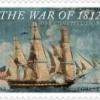
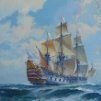
.thumb.jpg.ad2478a8fc78865f0504cc609074bce8.jpg)


